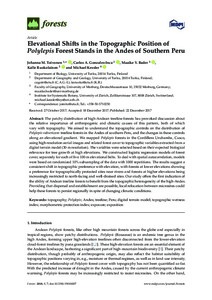Elevational Shifts in the Topographic Position of Polylepis Forest Stands in the Andes of Southern Peru
Johanna M. Toivonen; Carlos A. Gonzales-Inca; Maaike Y. Bader; Kalle Ruokolainen; Michael Kessler
https://urn.fi/URN:NBN:fi-fe2021042718403
Tiivistelmä
The patchy distribution of high-Andean treeline forests has provoked discussion about
the relative importance of anthropogenic and climatic causes of this pattern, both of which
vary with topography. We aimed to understand the topographic controls on the distribution of
Polylepis subsericans treeline forests in the Andes of southern Peru, and the changes in these controls
along an elevational gradient. We mapped Polylepis forests in the Cordillera Urubamba, Cusco,
using high-resolution aerial images and related forest cover to topographic variables extracted from a
digital terrain model (30-m resolution). The variables were selected based on their expected biological
relevance for tree growth at high elevations. We constructed logistic regression models of forest
cover, separately for each of five 100-m elevational belts. To deal with spatial autocorrelation, models
were based on randomized 10% subsampling of the data with 1000 repetitions. The results suggest a
consistent shift in topographic preference with elevation, with forests at lower elevations showing
a preference for topographically protected sites near rivers and forests at higher elevations being
increasingly restricted to north-facing and well-drained sites. Our study offers the first indication of
the ability of Andean treeline forests to benefit from the topographic heterogeneity of the high-Andes.
Providing that dispersal and establishment are possible, local relocation between microsites could
help these forests to persist regionally in spite of changing climatic conditions.
Kokoelmat
- Rinnakkaistallenteet [27094]
